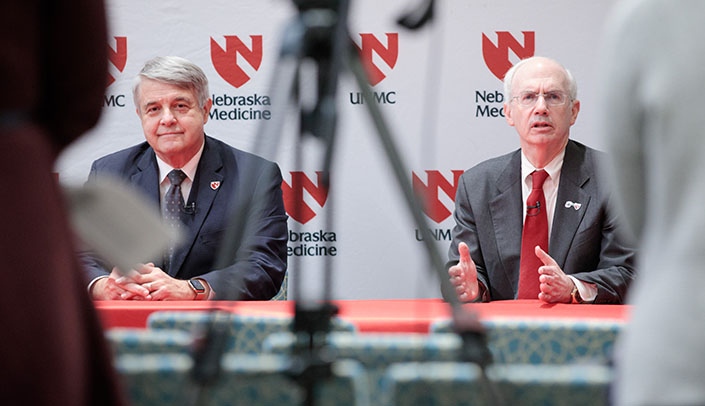Leaders at Nebraska Medicine and the University of Nebraska Medical Center (UNMC) unveiled early plans to propel the med center campus and the state of Nebraska to the highest levels of clinical care and research with the construction of a new, state-of-the-art facility, scheduled to take shape over the next decade.
The public/private partnership will have goals of: improving the quality of life for all Nebraskans and laying the groundwork for the state’s 21st century economy and create a new future of health care, research and education for our region, nation and the world.
The project, which is in such an early phase it currently doesn’t have an official name, could consist of several new buildings, to be constructed on the northwest corner of the current medical center campus. Buildings in the complex could include one or more new towers for research and inpatient care, which would consolidate care in one location and replace older facilities, some of which are more than 70 years old.
Strategic investments would also allow this facility to be a hub for expanding clinical trials and enrollment, new educational technologies and to become a magnet for medical tourists.
“We want the medical center to continue to be a prime mover in propelling Nebraska’s economy to new heights,” said Jeffrey P. Gold, MD, chancellor of UNMC and the University of Nebraska at Omaha. “This project will do just that. It will strengthen our position as a leading generator of new economic growth. We will train even more health professionals from around the world and recruit faculty and staff who are stars who will then attract more federal funding, corporate investment and patients from around the globe.”
He added, “Building on the success of the Fred & Pamela Buffett Cancer Center and numerous other successful projects, it is projected that these new facilities will expand educational workforce development in the health professions, be the home for even more cutting edge high impact research and continue our long tradition of serious medicine and extraordinary care.”
The public-private partnership between the medical center, the public sector, and the private sector may lead to new opportunities to collaborate with the federal government which could expand UNMC/Nebraska Medicine’s reputation in treating highly infectious diseases and national readiness and training of federal and civilian employees. This type of collaboration could develop space, which would normally serve as inpatient care, which could also be available to treat military and civilian federal employees in times of national or global need.
“Since the west Africa Ebola outbreak in 2014, Nebraska Medicine has led the world in bio preparedness efforts,” said James Linder, MD, CEO of Nebraska Medicine. “This new facility would be a quantum leap forward in that regard. So we’re not only advancing training, education, research and patient care, but we are also surging forward in the emerging fields of bio preparedness.”
UNMC/Nebraska Medicine has had an increasing role as a collaborator with federal civilian and military agencies. Following the Ebola crisis, UNMC/Nebraska Medicine became a co-leader of the National Ebola Training and Education Center (NETEC) and separately the home of the national HHS Training, Simulation and Quarantine Center. In addition, the US Air Force designated UNMC/Nebraska Medicine as one of its four Centers for Sustainment of Trauma and Readiness Skills (C-STARS) and the only one dedicated to specialized training for Air Force medical teams managing highly infectious disease threats.
“This type of public private investment is proven to work,” Dr. Linder continued. “This project will support new patient care delivery models that are not only more cost effective, but enable state-wide partnerships. This positions Nebraska as a hub of activity for knowledge-based companies and entrepreneurs. It will serve as a forerunner of future investments in Nebraska for decades to come.”
As the project is still in its infancy, specific costs will be established as it takes shape. Early estimates project that costs could be in the range of $1 – 2 billion depending on scope, a figure that is in line with other prominent academic medical center projects nationally. Architectural renderings and program specifics for the facility are not yet available.
